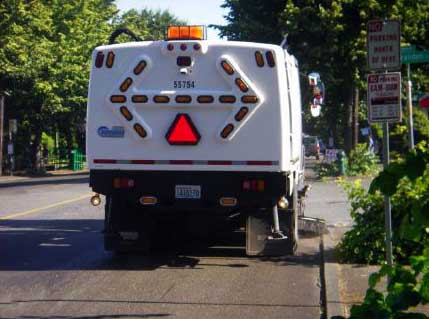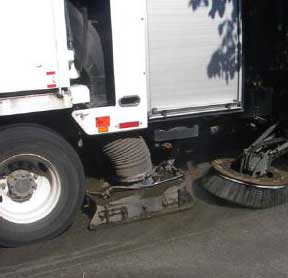Seattle Pilot Study Quantifies Sweepers' Positive Effects on Water Quality |

Analysis of this Seattle Pilot Project was completed by the Drainage and Wastewater Division of Seattle Public Utilities, in conjunction with Herrera Environmental Consultants.by Ranger Kidwell-Ross Like other coastal areas of the U.S., Puget Sound is facing an increasing level of degradation created by point and non-point source pollution. In the summer of 2006, Seattle Public Utilities began a one-year street sweeping study designed to determine the effectiveness of sweeping as a front-line pollution prevention BMP. Results were released in mid-2009. Project Overview:Seattle Public Utilities is responsible for managing the quality and quantity of stormwater discharged from the public storm drain system, which serves an estimated area of 40,800 acres in the Seattle metropolitan area. SPU undertook this investigation in part to respond to the requirements of its National Pollutant Discharge Elimination System (NPDES) municipal stormwater permit, which requires the City to implement a variety of projects and programs to improve stormwater quality. 
Additionally, this study investigates whether street sweeping can be effective in reducing the effect of City outfalls on sediment quantity and quality in the offshore receiving environment. Because Seattle is largely built-out, there is little undeveloped land available to site large regional stormwater treatment facilities. Therefore, source control is an important component of the City's stormwater program. Street sweeping has the potential to be an effective source control strategy by preventing a significant amount of sediment and associated contaminants from being discharged to receiving waters, which not only impacts water/sediment quality but also impairs substrate quality. Other potential benefits included reduced flooding, better aesthetics due to less trash on roadways, and improved air quality due to reductions in street dirt. Under its NPDES permit, Seattle is required to annually inspect each of the estimated 35,000 to 40,000 catch basins in the City and to clean these when the sediment depth exceeds 60 percent of the sump depth, or where the minimum clearance between the sediment surface and the invert of the lowest pipe is less than 6 inches (Ecology 2005, 2007). Catch basin inspection and cleaning constitutes nearly 60 percent of SPU's $3.7 million drainage-related maintenance budget. If street sweeping can reduce the frequency at which catch basins require cleaning, SPU could realize a significant savings in its maintenance budget for catch basin cleaning. Seattle is also involved in a number of state and federal cleanup projects involving contaminated sediment in several of the large water bodies offshore of the City (e.g., Duwamish Waterway, Lake Union, and East Waterway). Ongoing discharges from City storm drains have been identified as a potential source of pollutants to these water bodies. Reducing the amount of pollutants discharged by expanding or improving street sweeping practices could minimize the potential for sediments to become recontaminated following cleanup and reduce the City's overall liability should contamination reoccur in the future. Pilot Study DesignThe SPU project team elected to use a mass balance approach, which focuses on measuring the amount of sediment and associated pollutants present on the street, removed by sweeping, and accumulated in catch basins between test (swept) and control (unswept) sites, rather than measuring stormwater quality to quantify the effects of street sweeping. This decision was based, in part, on previous sweeping studies that often had difficulty showing statistically significant improvements in stormwater quality due to high temporal and spatial variability of stormwater flows and pollutant concentrations, and consequent difficulty in detecting measurable differences between the control and test sites. In addition, SPU conducted a baseline stormwater quality investigation in 2005 to determine if it was feasible to collect the numbers of samples needed to obtain statistically significant results for the pilot study (Herrera 2006) within the project funding constraints, which assumed a two and half year study collecting 12 samples per year for a total of 30 samples per site. 
Six grab samples were collected in each of two paired catchments, which are typical of residential sites in Seattle, and selected water quality parameters were analyzed. A power analysis showed that the number of samples required would be cost prohibitive due to the variability of stormwater quality and low pollutant concentrations in the samples. At the target level of sampling (30 samples), stormwater sampling would be able to detect a difference (relative to the mean) of approximately 190 to 370 percent for total suspended solids; 40 to 70 percent for total phosphorus; 10 to 220 percent for motor oil; and 40 percent for dissolved copper. Because this level of uncertainty was unacceptable, a mass balance approach on stormwater solids (i.e., street dirt, sweeper waste, and catch basin sediment) was employed in this study. Test sites (Figure ES2) were selected in two residential areas (West Seattle and Southeast Seattle) and one industrial area (Duwamish Diagonal). At each test site, two 4-15 block areas were identified, one control (i.e., unswept) and one test site (i.e., swept). Test Results and ConclusionsSediment and Pollutant RemovalStudy results clearly showed that sweeping each side of the street every other week is very effective in reducing the amount of sediment and associated pollutants discharged from city streets. Sweeping reduced the amount of dirt per unit area of street (referred to in this report as street dirt yield) in all three study areas. The median monthly street dirt yield at the swept sites was 48, 74, and 90 percent less than the control (unswept) sites in Duwamish Diagonal, West Seattle, and Southeast Seattle, respectively. On an annual basis, sweeping removed approximately 2,200 to 3,100 pounds of material per acre of street swept (referred to as sweeper waste yield) and the amount was similar at each of the three test areas. Sweeping can also reduce the amount of pollutants discharged from City streets to area receiving water bodies. Contaminants found in street dirt, sweeper waste, and catch basin samples included metals, petroleum hydrocarbons, and phthalates. Of these chemicals in the 55 samples analyzed, motor oil (82 percent), carcinogenic PAHs (78 percent), di-n-octylphthalate (65 percent), bis(2-ethylhexyl)phthalate (60 percent), butylbenzylphthalate (35 percent), di-n-butylphthalate (29 percent), zinc (18 percent), and chromium (15 percent) concentrations were above the Washington state sediment/soil standards and guidelines. Effect on Catch Basin CleaningAt the start of the pilot study, it was anticipated that street sweeping would reduce the amount of sediment that accumulated in area catch basins and, thus, would reduce the frequency at which catch basins needed to be cleaned. However, test results did not show that street sweeping affected the amount or rate of sediment accumulation in the test area catch basins. Cost-EffectivenessStreet sweeping has the potential to be a cost effective strategy for removing sediment and associated pollutants from roadways in the City of Seattle and is likely to be more cost-effective than annual catch basin cleaning or stormwater treatment. Costs for a full-scale sweeping program were estimated based on SDOT's 2006 unit costs ($35 per curb mile) using a 3 percent inflation factor and a 15 percent contingency to convert to 2008 dollars, for a total of $43 per curb mile. Solids handling and transportation costs were estimated at $34/wet ton and solids disposal was approximately $43.50/wet ton. Estimated life cycle costs for a full-scale street sweeping program ($0.34 per wet kilogram of material removed and $0.62 per dry kilogram of material removed) are generally lower than the costs for the SPU city-wide catch basin cleaning program ($0.42 per wet kilogram and $0.74 per dry kilogram). Street sweeping is also cost effective compared to treating stormwater prior to discharge. A rough comparison was made by converting the total mass removed by sweeping to a comparable stormwater TSS load. This adjustment was necessary because stormwater treatment facilities are typically evaluated based on their ability to remove TSS, which does not include larger particles associated with the bedload fraction that is included in street sweeper and street dirt measurements. SPU estimates stormwater treatment costs for capital projects based on dollars per kilogram dry TSS removed. Life cycle costs for recent estimated regional-scale stormwater treatment projects in Seattle have ranged from $10 to $30 per dry kilogram TSS removed. In Seattle, regional projects typically involve project areas of 200 to 300 acres. In comparison, life cycle costs for street sweeping are estimated at approximately $5 per kilogram dry TSS removed or approximately 15 to 50 percent of regional stormwater treatment costs. RecommendationsBased on the results of the pilot study, it is recommended that the City begin pursuing an expanded street sweeping program to reduce the amount of pollutants discharged to area receiving water bodies from City streets. The program should start by prioritizing areas within the City where water/sediment quality improvements are most needed and where street sweeping has the greatest potential to improve water and sediment quality (e.g., arterials and curbed roads in separated or partially separated areas). Because the pilot study showed that a sweeping frequency of once every two weeks was effective in reducing sediment loading, it is recommended that this frequency be established for any new areas. In addition, the sweeping frequency should be increased to once every two weeks in existing areas that are currently swept less frequently. A sweeping frequency of once every two weeks can be achieved by sweeping alternate sides of the street on the same day each week, which would be relatively straightforward to implement from an operations, parking management, and public relations perspective. Given the magnitude of parking related issues in Seattle, the City will need to develop a parking management public relations plan as well as continue to work closely with the Seattle Police Department's Parking Enforcement Division regarding the implementation of any future ticketing efforts. The pilot study did not answer a number of questions related to street sweeping that are important for the City of Seattle. Further investigation is recommended in the following areas: 1. Evaluate whether street sweeping can also be cost effective in areas without curbs. Many of the streets in the industrial sections of Seattle are not curbed. Because industrial streets have the potential to contribute a significant pollutant load to Seattle area water bodies, it is important for the City to develop a cost-effective strategy for dealing with these roadways. 2. Continue to evaluate street sweeping performance by monitoring the mass of sweeper waste removed and tracking how mass removal rates vary with the type of streets swept (e.g., land use, traffic volume, number of parked cars, and the absence of curbs). 3. Continue to evaluate the effectiveness of street sweeping at reducing drainage system maintenance costs. While this study showed that sweeping had a negligible effect on reducing catch basin sediment buildup, this result is counterintuitive and should continue to be studied as it has the potential to save the City considerable money if justified by further analysis. To access the entire 36mb pdf file report, which includes much more data and details including violation rates and other information on Seattle's vehicle 'no-park during sweeping' program, click here. Note: The following player links to an audio interview with Terry Martin conducted in July of 2009. In it, Martin provides an audio overview of the methodology and results of his agency's street sweeping study. The audio interview is approximately 25-minutes in length and will play without downloading any files onto your computer. If you hear the interview at 'chipmunk speed,' you will need to download the latest version of Adobe's free Flash player. Terry Martin, P.E., is the Acting Director Asset Management and Economics Services for Seattle Public Utilities. Martin may be reached by phone at 206-615-1744. His email address is Terry.Martin@seattle.gov. Consultants for the project are: Rob Zisette, of Herrera Environmental Consultants, who may be reached by calling 206-441-9080. Rob's email address is: rzisette@herrerainc.com. 930-6585 is cell WorldSweeper.com also reported on this study when it began. To see the initial parameters and design of scope, you will want to check out that article. |
© 2005 - 2019 World Sweeper All rights reserved. | Street Contents
|